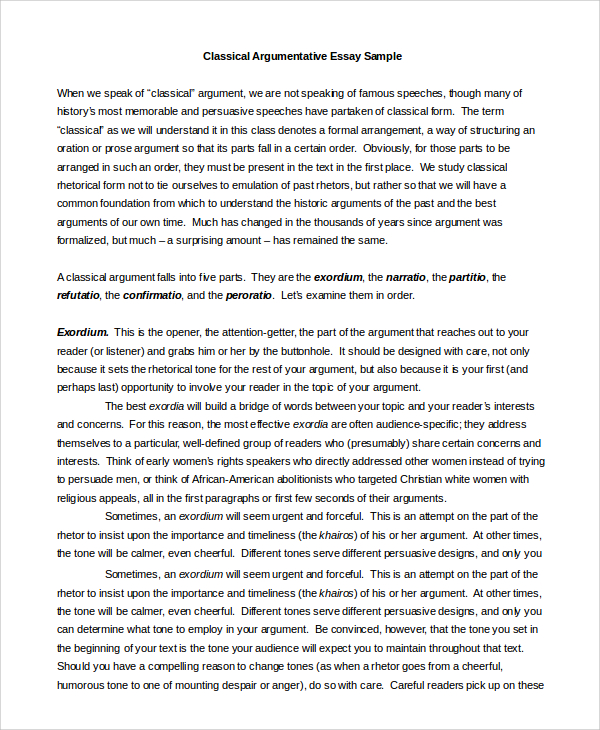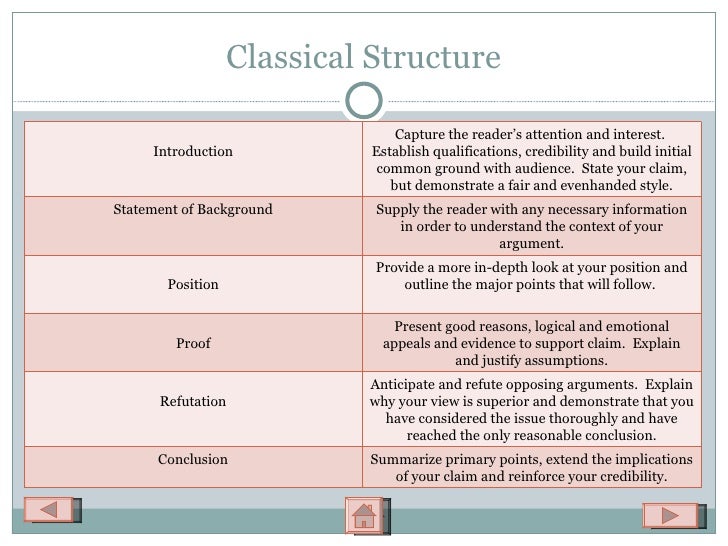
Classical Argument Structure: I. Introduction to general topic which leads to a clear thesis II. A moment of definition, background, and/or precedence (this is a section which clarifies and gives history on the topic or your stance on it). III. Support 1: This is typically the most logical reason why one should support your claim. a. Evidence b simplest form, the classical argument has five main parts: 1. The. introduction, which warms up the audience, establishes go odwill and rapport with the readers, and announces the general theme or. thesis. of the argument. 2. The. narration, which summarizes 1 day ago · It classical argument examples point to your ability to collect and select only the most relevant sources. Besides, direct and indirect quotes are needed to support your knowledge of academic writing style. If you are not sure in your writing skills, turn to professional writing agency to buy a winning argumentative essay on a variety of topics
Persuasive essay: Classical argument examples
The second essay format I teach my students is the classical argument. It is more advanced than the classical argument examples argument for a number of reasons.
To begin with, the thesis in a classical argument is debatable in a consequential way, meaning there is something at stake. That something might be political, social, religious, or any number of things that affect the broader world. In a middle school classical argument examples like mine, I might use a simple argument for analysis of King Arthur but a classical argument for analysis of the justice of the Crusades.
Given their complicated history and enduring legacy, a meaningful position on the Crusades requires research and attention to a vast array of conflicting viewpoints. The essay structure itself consists of five parts, which support a single classical argument examples statement through deductive writingmeaning they begin with the thesis statement and then move on to support it, classical argument examples. Happily, the introduction of a classical argument models the same format as that of a simple argument.
It introduces the topic to be discussed and presents the thesis statement. I instruct students to limit themselves to approximately sentences. The brevity of the opening paragraph is one of its strengths and should not be compromised by extraneous information. This paragraph consists of three parts. The first is the opening sentence itself.
This should typically consist of a simple statement of fact, especially for students who are just learning to write an essay for the first time. The second part of the opening paragraph offers transitional background information and justification for why the topic is classical argument examples. Well-done transitional sentences pave the way for the final part of the opening, which is the one-sentence thesis itself, classical argument examples the position the essay takes, classical argument examples.
I always remind students that the thesis should be something debatable much like an opinion. In other words, it is not simply a fact. This part of the essay establishes context for the argument. First, classical argument examples, it tells the story, so to speak, behind the essay. That story might be the history of a war or the facts of a case or some other relevant background.
Next, it addresses the reality that there are opposing views about the subject matter. It should state what those views are without actually getting into the arguments for either position. That will come later. Finally, classical argument examples, the narration makes a type of appeal to the reader, letting him know what is at stake in the essay and asking him to weigh each side carefully. There is no set number of sentences, but a good paragraph of sentences usually does it for middle school students.
More advanced writers might write several paragraphs in this part. Much like the body of a simple argument, the confirmation presents the evidence to support the thesis. It should have a topic sentence, at least three pieces of thoroughly explained evidence, and a concluding sentence that clearly ties the confirmation back to the thesis, classical argument examples.
Again, a good paragraph of sentences is ideal for middle school students, classical argument examples more advanced writers might have several paragraphs in this section as well. It should have a topic sentence followed by as many objections as the writer can come up with. If there are areas where the opposition may have a good point, the writer should concede that but without giving full weight to their overall position.
Finally, this part classical argument examples the essay should have a concluding sentence that relates back to the thesis. The refutation and concession should mirror the confirmation in structure and length.
Its purpose is to drive home the thesis statement by casting its relevance more broadly than what was initially presented in the introduction and narration.
Beginning writers often erroneously think of a conclusion as a restatement of what has already been said. Though this might work on a basic level, it represents only a superficial understanding of the key purpose of the conclusion and tends to be boring.
We often think of it in terms of the broad lessons we learned from exploring an argument in a specific context. The conclusion should be divided into three parts, inversely mirroring the introduction. It, too, should be relatively short but powerful. The first part of the conclusion recalls the thesis but presents it classical argument examples a new way. If the writing process is classical argument examples for the simple argument, it is all the more important for the classical argument, which is far more complicated.
From using Socratic discussions and disputations, to developing a thesis, classical argument examples, to outlining classical argument examples argument, to writing it out, every phase needs thorough, well-planned attention.
Any breakdown in the writing process can greatly undermine the strength of the argument, and it shows all the more in this essay format. Conversely, careful adherence to the process results in a persuasive argument even if the writing is wanting in style and beauty.
The classical argument, when followed properly, is as full-proof of a persuasive format as it gets. Naturally, there will be many readers who are not convinced in the end, but they will at least have to concede that the argument is convincing. The Writing Lesson by Morris Shulman. A Lady Writing by Johannes Vermeer. Share this: Click to share on Facebook Opens in new window Click to share on Twitter Opens in new window Click to share on LinkedIn Opens in new window Click to share on Pinterest Opens in new window Click to email this to a friend Opens in new window.
Like this: Like Loading Previous Article Essay Writing 3: The Simple Argument. Next Article Essay Writing 5: The Personal Argument. Send to Email Address Your Name Your Email Address Cancel Post was not sent - check your email addresses! Sorry, your blog cannot share posts by email, classical argument examples.
Classical Arguments
, time: 8:49Sample Classical Argument

Sample Classical Argument Is Schooling Conducive to Learning? If students get As on a test then they know the material, right? How many of those students would still know the information if you asked them about a week later? How about a month later? Most students will not remember most of the information for very long after the test In some examples of classical arguments, the narration comes together with the introduction. Confirmation This is where the speaker/writer gives the supporting evidence to the claim Thesis statement, background, lines of argument, rebuttal, conclusion Classical argument structure = outline. Note: one does write a paragraph about yourself for a job NOT present a thesis statement in the introduction in the Classical Argument model An argument essay is best served by a topic that can be
No comments:
Post a Comment